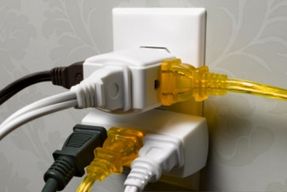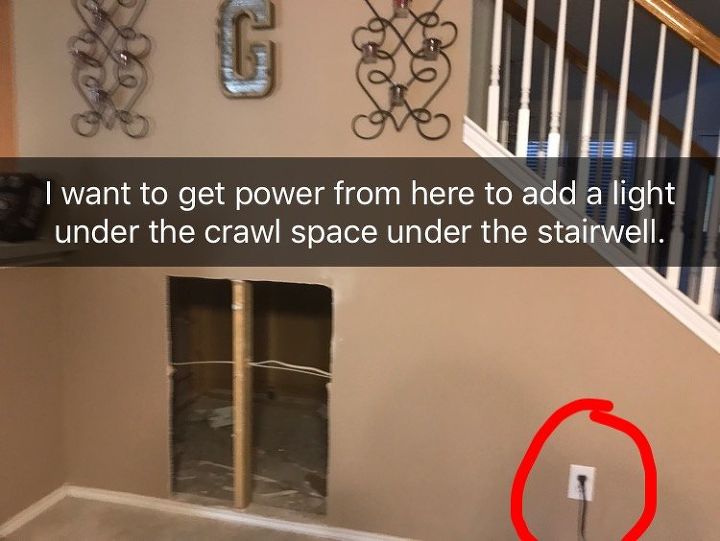How can I know if I'm overloading an electrical outlet?

 Video processing...
Video processing...
Related Discussions
How to get rid of mice?
We seem to have some unwelcome Mickeys and Minnies in our house. What is the best way to get rid of them?
How to remove popcorn ceiling with asbestos?
I want to remove my popcorn ceiling, but it has asbestos in it. How do I go about this safely?
How to caulk baseboard gaps?
How do I fill gaps at baseboard, should I caulk? If so, does anyone know how to caulk baseboards?
How to fix squeaky hardwood floors?
How do I fix squeaky hardwood floors?
Can I draw power from a wall outlet to add a light and light switch?
How can I install a FLOOR outlet in hardwood/concrete?
I live in a log cabin. My foundation in concrete and my flooring is hardwood. I need a floor outlet in the floor away from the wall. How can I do that without goi... See more







You can buy a strip that is a surge protector. Make sue it says surge protector. It may cost a little more but do buy it over the others. I live in Florida where our lighting storms are legend. I have a surge protector strip, it has never let me down.
First picture is not safe. That is an overloaded outlet. Touch some of the cords, if they are warm, they can become a fire hazard. Most power strips will be marked if they are a surge protector. Some are combination power strips and surge protectors. A few outlets would be surge protected and the rest would not.
first things first, you definitely need a surge protected strip. It not only will keep your cords at a safe level to prevent "surge spikes" when the power is interrupted and reapplied(which is when a surge spike occurs) but it will keep all of your devices protected and functioning. One way to tell if an strip is surge protected is it will say it is both on the box that it comes in and somewhere on the strip itself.
In addition, don't skimp on the amperage power. Generally the higher the amps the more load (devices) you can have, but DO NOT exceed the amps of the outlet itself. I couldn't make out where you have this outlet but it is safe to say it is probably 15 amp. All electrical devices MUST state the amperage that it uses and don't worry about using over the amperage unless you intend on using ALL your devices at the same time (not probable).
Hope this helps you
Sorry, but I lack a lot of knowledge here. When you say not to exceed the amps of the outlet itself, "outlet" is the thing built into the wall to plug things into, right? And how can I know how many amps it has so I don't buy a surge protector that exceeds its amperage?
I figured the photo was not yours =:) If you buy a surge protector everything you plug in will be protected. Some even have a phone, data, and USB port which are protected. The combination surge have protected outlets for surge expensive devices that have intricate microprocessors, computers, televisions, other expensive electronics. The surge protector ensures that only the normal, safe amount of electricity passes through to your devices. The regular outlets are for accessories that are not that sensitive to surges, table lamps, your standing/desk fan. Think of it this way: if there was an electrical surge that destroyed all of the devices connected to your outlets, which lost devices would pain you the most? Plug those into a surge protector. It’s better to be safe than sorry. ***** https://wiki.ezvid.com/best-surge-protectors?id=adw&gclid=CMruu5C7iNICFRC1wAodtmoNyQ
I would ask an electrician. One can put a whole house surge protector on at the breaker box if you have the room on your box per an electrician. I have not sprung for that yet and still have the individual surge protector on my computer and accessories. However, if you live in a high surge area it would be cost effective. When I lived close to a lake in Nashville we had several power surges that were quite costly to TV, microwave, and a Satellite dish black box.
There will be a tag or printed information on each piece of equipment that states the maximum amperage it will use. e. g. 120/250V . Amperage 2.4. This means the unit can be used by either 120 volts or 250 volts and uses 2.4 amps of power. Add all of the amperage together from the units and that will tell you if you are exceeding the max amps of the outlet. The wire going to that outlet determines the amperage for the outlet. You can't change fro a 15 amp outlet to a 20 without changing the wire. Just remember if you have several units plugged in and they exceed max amps, one or two of them cannot run at the same time as the others.
IMPORTANT TO BEAR IN MIND: Surge protectors work initially. However, after about a year, they should be considered: multiple-outlet appliances ONLY. Even though you aren't aware of it, surges are happening all thru the year, and the surge protector simply wears out, and you are NOT as protected as you think. I know this is bad news, but knowledge is power (pardon the pun). : ) You don't want your toys fried.
Bummer!
Ok..I was surprised too when an electrician told me that those surge protectors need to be replaced if you know that you've had a strong storm go thru....kinda makes sens.
Unless a receptacle is dedicated, which means it's on a circuit by itself, the electrician typically wires several receptacles together on one 15 or 20 amp circuit. So, a receptacle in a different room might still be on the same circuit. If a circuit is overloaded, the breaker should trip. You can look in your breaker box to see the capacity of each circuit. We were taught to use a max of 80% of the capacity, so add up the amps for each appliance and don't exceed 12 amps on a 15 amp circuit or 16 amps on a 20 amp circuit. (Because some things have a small surge when they're first switched on)
I live in a very remote area according to some people, and rent, so having an electrician installing an ACTUAL-surge protector in my electrical panel, my computer guy suggested that I purchase a Battery back-up unit " Office Depot". It not only gives me 121 minutes of run time when the power goes out, but has multiple outlets which have surge protection built in. One outlet to plug it in(you still need to make sure if the outlet circuit has the proper and not overloaded amps), and then I plug my accessories into it. The instructions even says you can use it for more than just computer related items. Flat screens, game consoles,DVR, etc. I went for the mid- to higher range, just because I have a lot of power outages, and limbs falling on the power lines causing surges!
You must have surge protector, it's a must. I live in Florida, the lighting capital and have called my power company. They installed in breaker box surge protector. I also have surge protector s on all outlets. I even have inline protectors on all appliances. If you think about it. Just on surge can cost thousands of dollars in damages. Verses the low cost of protection.
Check with your power company first. Some power company's offer them at low or no cost. In my area my power company offered for free. The reason most consider offering them is to protect the line service. Consider what can happen if a lighting power surge back feeds to the transformer. Not only will this burn out or damage your home but can damage all homes on the power company's transformers. If you chose to use plug in protection make sure u all up all the rooms power needs. You still should no go over 80 0/0 amps that the breaker can handle. All appliances and lighting have this amp usage on labels.
Thanks for all of the info. I never understood it before. Glad to gain this knowledge!
get your Megger out, use ohms law. test the resistance of the circuit. Next make sure the phases are correct. If you must, test transformer at pole. Get your triple nickel and bend back to back offsets. Make up a head and pull it in. Add some lube to conduit. Put your CTs in making sure the line side is correct. If you have a emon demon it'll be a split core system so landing your load before installing your donuts is not a big deal. Call your boss and have wire stretcher dropped off with the bucket of steam. Lastly, grab the fiberglass fish and pull in two #12 thhn circuits and put back the blank 1900 covers.
Surge protector bars are good, and I have a dedicated surge protector outlet for my treadmill, which keeps it running smoothly. I had an insurance house inspection this summer. We have an outdoor light with a timer plugged into a powerstrip in our garage. There is nothing else plugged into it. It was set up that way by the previous owner. The inspector told us that there are 2 things (amongst many I guess, lol), that they do not like to see: extension cords, and power bars. They are according to him, fire hazards plain and simple, and we were told to remove it.
You have to measure the power of that outlet by using a Multimeter. A digital multimeter is available in the market with extra benefits.
Then the calculation comes. The more electrical appliance you connect the more power comes through that outlet. And every appliance have a description about how much power it needs to run. Then the calculation is simple. Summation of the power consuming by electrical appliance must not be greater that the outlet. Hope this will answer your question. And one more thing, a digital multimeter will save your time, money and sometimes life. So it is very useful to keep one at home or office.
If your electrical outlet is overloading then it's dangerous . You need to check your electrical outlet using best multimeter. You can also use multimeter for hvac work.